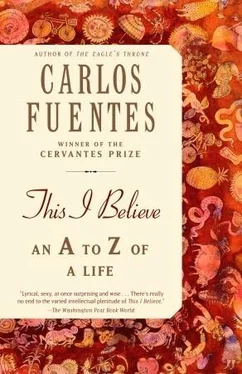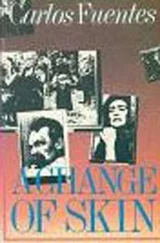In the end, there is something else that cannot be separated from the love of film, and that is the love and fascination one feels for the cinematic face. Once, while watching Dreyer’s Passion of Joan of Arc with Buñuel, the great filmmaker from Aragón confessed his fascination with the facies, the cinematic face. In the end, there can only be one Falconetti, and perhaps that is why Dreyer’s Pucelle made only one film in her lifetime.
But repeated yet unique, enchanted dust that we are, what would our lives as twentieth-century humans be without the beauty, illusion, and passion granted us by the faces of Greta Garbo and Marlene Dietrich, Louise Brooks and Audrey Hep-burn, Gene Tierney and Ava Gardner? For this reason, I adore finding references to the gaze within the gaze in the movies.
Bogart to Bergman in Casablanca: “Here’s looking at you, kid.”
Gabin to Morgan in Port of Shadows: “You got pretty eyes, you know that?”
This is the great miracle of the cinema: it conquers death. Garbo’s face in the last scene of Queen Christina, Louise Brooks’s face and profile with that crow’s-wing hairstyle in Pandora’s Box, Marlene’s face amid the gauze and baroque filters of Shanghai Express and The Scarlet Empress, María Félix daydreaming as she is serenaded in Enamorada, or Dolores Del Rio seeing her own death in that of Pedro Armendáriz in Flor Silvestre, or Marilyn’s face as she descends the diamond-studded staircase or as she fights the New York summer steam that rises up beneath her white skirt revealing her white thighs in The Seven Year Itch. These faces, ultimately, are the final and absolute reality of film: none of them can grow old or die. Film made them eternal. They are the cinema’s victory over old age and death.
No theory or artistic triumph can eclipse or eliminate that simple truth. It is our reality, our most intimate yet most shared love affair, and we owe it all to the cinema.
A modern state, in any part of the world, must now confront a global economy that surpasses all national laws and borders.
How can the inequalities brought about by globalization be corrected?
How are individuals to be prepared for the age of new and ever-increasing competition in all walks of life?
How can social welfare programs be restructured so that the most vulnerable citizens will not become victims of global Darwinism?
The Latin American state, in particular, must not proceed from protecting its inefficiency to protecting its injustice.
In a globalized world, local government plays a critical role in maintaining the social equilibrium within each nation, and this cannot be achieved unless public spending is kept at a level of at least 30 percent of the gross domestic product. This, in turn, requires promotion of internal savings and liberation from the vicious cycle that leads us to attract external capital with high interest rates, instead of encouraging productive capital with high savings rates. To achieve all this, there must be a complementary relationship, not a hostile confrontation, between the public and private sectors.
This is precisely where civil society — the third sector, the social sector — can play a critical role by building bridges between the public and private sectors, by putting an end to pointless antagonisms, by advocating the compatibility of collective interests, and by acting on its own in areas that the other two sectors cannot occupy, describe, or even, occasionally, imagine.
Sometimes, when bureaucracy is blind, civil society is better equipped to identify, with greater speed and accuracy, the needs for development: for example, the problems of the forgotten village, the invisible neighborhood, the working mother.
And at other times, when private enterprise sees only a lack of profit, the social sector can discover or invent the best way to employ local resources and set up initiatives that will allow the less fortunate to help themselves: day-care centers, cooperatives, credit systems, shared medical and pharmaceutical plans, personal and public health programs, educational support, and door-to-door illiteracy programs if that is what is needed.
Or reading groups, or incentives for encouraging local theater. Savings banks, neighborhood associations, family medicine programs. Small, flexible, original, and renewable, third-sector organizations can be pioneers for governmental or private sector initiatives.
And they fulfill a political function that may be less visible but certainly not less critical. They help establish the public agenda. They empower people.
This is particularly true in Latin America, where we continue to be two nations, the term used by Disraeli to describe mid-nineteenth-century England caught between industrial development and social backwardness. We are indeed two nations: Brazil rather wryly calls itself “Belindia”—part Belgium, part India. In Latin America, the Mercedes and the mule, the skyscraper and the slum, the supermarket and the garbage dump, the baroque and the barock ’n’ roll all coexist, and the television aerial is the new cross of the neighborhood parish.
I believe that the third sector’s principal challenge in Latin America is that of creating bridges between these two nations, advocating human development as the starting point for sustained economic development, with the understanding that global problems can only be resolved by tackling local problems: the village, the isolated community, internal migration, small farms, trades, neighborhood roads, rural schools, vocational training, and traditional craftsmanship.
Global health cannot exist without local health.
The success of the new democracies in Latin America will be determined by their ability to relate the notion of political liberty to that of social welfare.
The function of civil society is to “socialize” both the public and private sectors. And I will even venture a step further: civil society should colonize them, though always recognizing that civil society itself is constantly being colonized by the State and the corporate world.
This, then, is not about stagnant, hermetic compartments. To a certain degree, civil society is not unlike political parties that have one foot in society and the other in the institutional world.
For this reason, the oft-invoked notion of civil society as an entity uncontrolled by the public and private sectors is insufficient. Civil society criticizes public and private institutions but it can also enrich them, contaminate them, and offer alternative solutions for real prosperity.
The aim is to broaden the horizons of this mutating world, so that new structures can emerge, strengthened by new institutions that will be able to adapt to change with justice.
With respect to Latin America, I insist upon the need for raising our level of savings so that our production levels may grow; with this change, Latin America would be less dependent on speculative capital. And that, in turn, would attract productive capital.
This is an extremely broad topic, but its nuances are so minute that they often go unnoticed. Nevertheless, they are important enough to constitute a basis and a framework for what we understand to be the “third sector” or “civil society.”
To open up the channels between savings and productive investment, social welfare funds are necessary, as are savings banks, credit unions, and, in a general sense, access to credit in the interest of expanding the financial system and its scope. At the same time, systems of micro-credits must be encouraged and expanded. I will give one example that I think is sufficient to illustrate this point.
Читать дальше












